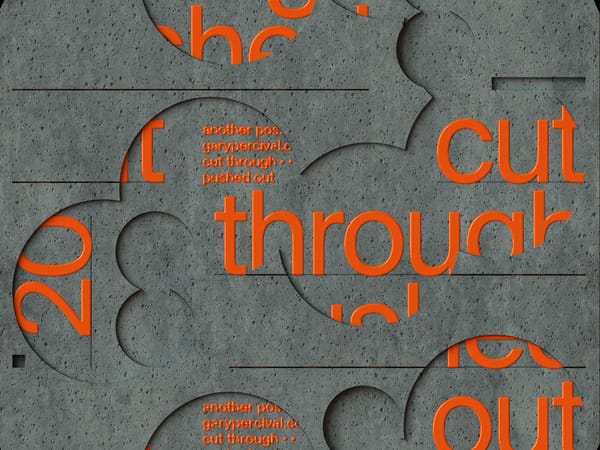Blame vs. Responsibility: Choosing the Path That Moves You Forward
“Professional growth isn’t about eliminating challenges; it’s about developing better ways to handle them.”

When things go wrong in creative work—and they inevitably do—we face a crucial choice in how we respond.
We can either focus on blame, pointing fingers at clients, circumstances, or even ourselves, or we can embrace responsibility, looking for ways to improve and move forward.
This distinction, while subtle, can dramatically impact our professional growth and success.
The Allure of Blame
Let's be honest: blame can feel satisfying in the moment.
When a project derails, a deadline is missed, or feedback is harsh, it's natural to want to identify culprits. The client didn't provide clear direction. The timeline was impossible. The brief kept changing. The software crashed.
Sometimes these factors are entirely real and legitimate. But focusing on them rarely helps us grow or improve our situation.
Blame, even when justified, keeps us stuck in past events and fosters a victim mentality. It damages professional relationships, prevents learning, and generates negative energy that can poison future projects.
Perhaps the worst of all, it reinforces a sense of helplessness—the feeling that circumstances control our outcomes rather than our responses to them.
Understanding True Responsibility
Responsibility in creative work isn't about taking the blame or accepting fault for everything that goes wrong.
Instead, it's about acknowledging our power to respond and influence outcomes. It's about asking, "What can I do now?" rather than "Who's at fault?"
This shift in perspective transforms our relationship with challenges. Instead of viewing ourselves as victims of circumstances, we become active participants in finding solutions.
We might develop better project management systems, improve our client communication strategies, or build more buffer time into timelines.
The specific actions matter less than the fundamental shift from passive recipient to active problem-solver.
The Power of Forward-Thinking Questions
The questions we ask ourselves in challenging moments shape our professional trajectory.
Beyond just changing our mindset, they influence our relationships, decision-making, and career growth.
When faced with a difficult situation, instead of asking, “Who’s to blame?” We might ask, “What can we learn from this experience?” Rather than wondering, “Why do these things always happen to us?” we can explore, “How can we prevent similar situations in the future?”
The simple act of reframing our internal dialogue changes not just our mindset but also our actual outcomes.
Consider these transformative shifts in questioning:
- Instead of "Why didn't this work?" ask, "What approach might work better next time?"
- Instead of asking, "Who made this mistake?" ask, "How can we strengthen our process?"
- Instead of "Why are we behind schedule?" ask, "What resources do we need to get back on track?"
By consciously crafting questions that open possibilities rather than assign blame, we create pathways to better solutions and stronger professional relationships. This shift not only improves our problem-solving capabilities but also helps build a culture of continuous learning and innovation.
The quality of our questions often determines the quality of our outcomes. When we make this simple yet powerful shift in our internal dialogue, we transform challenges into opportunities for growth and improvement.
From Setbacks to Solutions
Every challenge in creative work carries a hidden opportunity: the chance to refine and improve the way we operate.
A difficult client interaction might reveal the need for clearer contracts or stronger boundaries. A missed deadline might highlight gaps in time management or unrealistic expectations. Frustration with a project might signal the need for better collaboration tools or more structured feedback loops.
The key isn’t just to fix problems as they arise but to treat them as valuable insights—data points that guide us toward better systems and smarter ways of working.
This doesn’t mean we should passively accept every challenge or excuse poor behaviour. Instead, it’s about using each experience to sharpen our approach, ensuring that similar issues become less frequent or less disruptive in the future.
By shifting our perspective from frustration to refinement, we turn setbacks into stepping stones for long-term professional growth.
The Role of Boundaries in Professional Responsibility
Taking responsibility doesn’t mean accepting everything that comes your way.
In fact, setting clear boundaries is a crucial part of professional responsibility.
This includes:
- Developing comprehensive agreements that define project scope and deliverables
- Establishing clear communication expectations
- Maintaining high standards for both the quality of work and professional conduct
Strong boundaries actually make it easier to take responsibility because they create clear frameworks for decision-making and problem-solving.
When you know your limits and standards, you can respond to challenges from a place of confidence rather than reactivity.
Handling Difficult Situations With Grace
Even with the best systems and intentions, challenging situations will arise. The key is handling them with professional grace.
This means listening to concerns without becoming defensive, acknowledging others' perspectives while maintaining your professional standards, and focusing consistently on solutions rather than blame.
When you make mistakes—and everyone does—own them promptly and present a clear plan for correction. Use these experiences as opportunities for growth rather than sources of shame or defensiveness.
The goal isn't perfection; it's continuous improvement and professional development.
Creating a Legacy of Professional Growth
The choice between blame and responsibility shapes not just individual situations but your entire professional trajectory.
Those who consistently choose responsibility tend to develop stronger problem-solving skills, better client relationships, and more resilient professional practices. They build reputations not for being perfect but for being reliable, solution-focused, and professionally mature.
This approach creates a positive feedback loop: better handling of challenges leads to stronger client relationships, which often results in better projects and more referrals.
Meanwhile, the habit of extracting learning from every situation drives continuous professional growth and development.
Embracing the Journey
Professional growth isn't about eliminating challenges; it's about developing better ways to handle them.
By choosing responsibility over blame, we transform difficulties from sources of frustration into opportunities for development. We move from asking, "Why me?" to "What next?"
This shift doesn't happen overnight, and it's not always easy. There will be moments when blame feels like the natural response.
The key is recognising these moments as choices—opportunities to reinforce either a blame-focused or responsibility-focused approach to professional challenges.
Moving from Theory to Practice
The journey from blame to responsibility begins with small, deliberate steps.
Start by keeping a “response journal” for one week, documenting your initial reactions to challenges and then consciously reframing them through a responsibility lens.
Practice phrases like “What I can do about this is…” in team meetings instead of “The problem is…”
When giving feedback, focus on specific, actionable improvements rather than past mistakes.
Share your commitment to responsibility-focused thinking with trusted colleagues who can help hold you accountable.
Remember that this shift isn’t just about personal growth—it creates ripple effects that elevate entire teams and projects.
The Path Forward
The next time you face a professional challenge, pause before responding.
Notice your initial impulse toward blame, acknowledge it, and then consciously choose responsibility instead. Ask yourself what you can learn, what you can improve, and what you can do next. This simple but powerful practice can transform not just individual situations but your entire professional journey.
Remember, choosing responsibility doesn't mean never feeling frustrated or never acknowledging when others have contributed to problems. It simply means focusing your energy on what you can control and influence, rather than what you can't.
In doing so, you create not just better outcomes, but a stronger, more resilient creative practice—one built on growth, adaptability, and long-term success.



